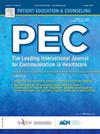项目符号是获取健康信息的灵丹妙药吗?社区健康信息偏好的横断面分析
IF 3.1
2区 医学
Q2 PUBLIC, ENVIRONMENTAL & OCCUPATIONAL HEALTH
引用次数: 0
摘要
本研究比较了社区对健康素养编辑器评估过程中生成的原始和简化卫生文本的偏好,该工具可提供关于普通语言使用的客观反馈。目的是探索低教育水平人群中健康素养编辑器使用、文本特征和健康信息偏好之间的关系。方法符合条件的参与者是居住在澳大利亚的成年人,没有英语本科学位。参与者观看文本对(原文和修订版),并根据可理解性、混淆度、对单词的熟悉程度、信任度、可操作性和分享意愿来报告他们的偏好。逻辑回归模型探讨了结果、试验组和文本特征(可读性、复杂语言、被动语态、专家健康素养评分、要点)之间的关系。结果150例患者平均年龄27.3岁(SD=13.7);50 %为男性;36% %在家说另一种语言。与对照相比,使用健康素养编辑器与对修订文本的更高偏好无关(例如,可理解性比值:1.25,95 %CI: 0.75-2.09, p = 0.39;混淆率OR: 0.73, 95 %CI: 0.44-1.21, p = 0.22;)。在所有参数(例如,可理解性OR: 2.35, 95 %CI: 1.40-3.97, p = 0.001;混淆度OR: 0.48, 95 %CI: 0.28-0.83, p = 0.009)上,使用项目符号的修订文本的评分比原始文本(没有项目符号)更有利。参与者认为专家评分较高的文本(即对简单语言的主观评分)比原始文本更容易理解(OR: 1.43, 95 %CI: 1.00-2.06, p = 0.050)和更少混淆(OR: 0.66, 95 %CI: 0.46-0.94, p = 0.021)。结论:参与者更喜欢使用项目符号的健康信息,以及更清晰的语言评分。进一步的研究可以探讨要点与社区接受卫生信息的相关性。实践启示研究结果支持使用要点和简单的语言来创建更容易被社区成员接受的文本。本文章由计算机程序翻译,如有差异,请以英文原文为准。
Are bullet points the silver bullet to accessible health information? Cross-sectional analysis of community health information preferences
Objectives
This study compared community preferences for original and simplified health texts generated during evaluation of the Health Literacy Editor, a tool that provides objective feedback on use of plain language. The aim was to explore the relationship between Health Literacy Editor use, text characteristics, and health information preferences amongst people with lower levels of education.
Methods
Eligible participants were adults living in Australia without an English-language undergraduate degree. Participants viewed text pairs (original; revised) and reported their preference according to: understandability, confusion rating, familiarity with words, trust, actionability, and intentions to share. Logistic regression models explored relationships between outcomes, trial group, and text characteristics (readability, complex language, passive voice, expert health literacy ratings, bullet points).
Results
Mean age of the 150 participants was 27.3 years (SD=13.7); 50 % were male; 36 % spoke another language at home. Use of the Health Literacy Editor was not associated with a higher preference for the revised text compared to control (e.g. understandability odds: 1.25, 95 %CI: 0.75–2.09, p = 0.39; confusion rating OR: 0.73, 95 %CI: 0.44–1.21, p = 0.22;). Revised texts that used bullet points were rated more favourably than the original texts (no bullet points), for all parameters (e.g. understandability OR: 2.35, 95 %CI: 1.40–3.97, p = 0.001; confusion rating OR: 0.48, 95 %CI: 0.28–0.83, p = 0.009). Participants rated texts with higher expert ratings (i.e. subjective ratings of plain language) as easier to understand (OR: 1.43, 95 %CI: 1.00–2.06, p = 0.050) and less confusing (OR: 0.66, 95 %CI: 0.46–0.94, p = 0.021) than the original texts.
Conclusion
Participants preferred health information that uses bullet points, and stronger plain language ratings. Further research could explore the relevance of bullet points to community acceptability of health information.
Practice implications
Findings support use of bullet points and plain language to create texts that are more acceptable to community members.
求助全文
通过发布文献求助,成功后即可免费获取论文全文。
去求助
来源期刊

Patient Education and Counseling
医学-公共卫生、环境卫生与职业卫生
CiteScore
5.60
自引率
11.40%
发文量
384
审稿时长
46 days
期刊介绍:
Patient Education and Counseling is an interdisciplinary, international journal for patient education and health promotion researchers, managers and clinicians. The journal seeks to explore and elucidate the educational, counseling and communication models in health care. Its aim is to provide a forum for fundamental as well as applied research, and to promote the study of organizational issues involved with the delivery of patient education, counseling, health promotion services and training models in improving communication between providers and patients.
 求助内容:
求助内容: 应助结果提醒方式:
应助结果提醒方式:


